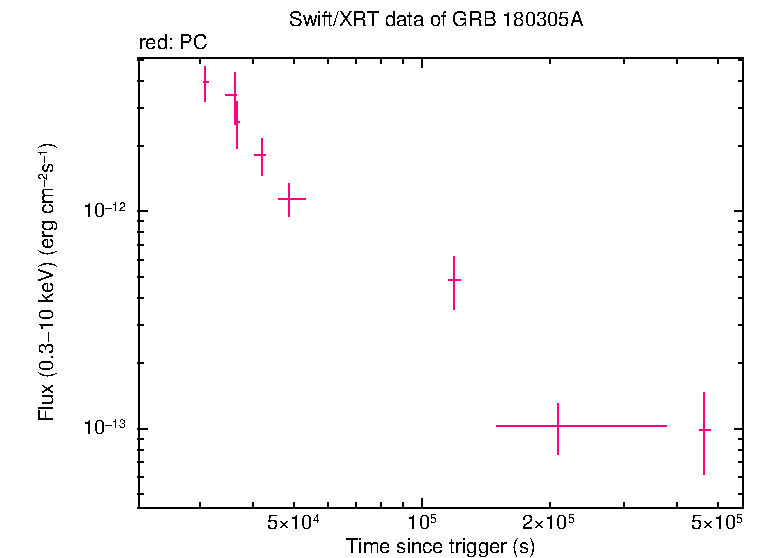
P. D'Avanzo (INAF-OAB) and S.W.K. Emery (MSSL-UCL) for the Swift team
Axelsson and Bissaldi (GCN Circ. 22457) reported the GRB detection. At 09:26:08.66 UT on March 05, 2018, Fermi-LAT detected high-energy emission from GRB 180305A, which was also detected by Fermi-GBM (trigger 541934773 / 180305393). Table 1 contains the best reported positions from Swift.
Troja et al. (GCN Circ. 22460) reported the position from RATIR for the optical afterglow of this GRB. Table 2 is a summary of GCN Circulars about this GRB from observatories other than Swift.
BAT did not observe this burst.
Analysis of the initial XRT data was reported by D'Avanzo et al. (GCN Circ. 22462). Four uncatalogued X-ray sources are detected, of which one ("Source 2") is above the RASS limit and fading with 3-sigma significance, and is therefore likely the GRB afterglow.
The light curve (Figure 2) can be modelled with a power-law decay with a decay index of α=2.7 (+0.5, -0.8).
A spectrum formed from the PC mode data can be fitted with an absorbed
power-law with a photon spectral index of 1.5 ± 0.4. The
best-fitting absorption column is 4.7 (+3.2, -2.3) x 1
The Swift/UVOT began settled observations
(Emery and Siegel GCN Circ. 22464) of the field of GRB 180305A 30621 s after the Fermi/LAT trigger (Axelsson et al., GCN Circ. 22457).
No optical afterglow consistent with the enhanced XRT position (D'Avanzo et al., GCN Circ. 22462) or the RATIR and Mondy detections (Troja et al., GCN Circ. 22460; Mazaeva et al., GCN Circ. 22463) is detected in the initial UVOT exposures.
Table 3 gives preliminary
magnitudes using the UVOT photometric system
(Breeveld et al. 2011, AIP Conf. Proc., 1358, 373).
No correction has been made for the expected extinction in the Milky Way
corresponding to a reddening of
Figure 1. The BAT light curve is not available.

Figure 2. The XRT light curve.
Any data from a crosshatched region are not included in the fit.
| RA (J2000) | Dec (J2000) | Error | Note | Reference |
|---|---|---|---|---|
| 0 |
+32°06'35.8" | 1.7" | XRT-final | UKSSDC |
| 0 |
+32°06'35.8" | 1.7" | XRT | D'Avanzo et al. GCN Circ. 22462 |
| Band | Authors | GCN Circ. | Subject | Observatory | Notes |
|---|---|---|---|---|---|
| Optical | Troja et al. | 22460 | RATIR Optical Afterglow Candidate | RATIR | detection |
| Optical | Mazaeva et al. | 22463 | Mondy optical observations | Mondy | detection |
| Optical | Watson et al. | 22465 | RATIR Optical Observations | RATIR | |
| Gamma-ray | Axelsson and Bissaldi | 22457 | Fermi-LAT detection | Fermi LAT | |
| Gamma-ray | Veres and von Kienlin | 22458 | Fermi GBM detection | Fermi GBM | Fluence=3.302±0.023x1 (9 |
| Gamma-ray | Svinkin et al. | 22461 | Konus-Wind observation | Konus-Wind | Duration=~44 seconds Fluence=8.43(-0.58,+0.59)x1 |
| Gamma-ray | Penacchioni et al. | 22467 | CALET Gamma-Ray Burst Monitor detection | CALET | |
| Gamma-ray | Sharma et al. | 22476 | AstroSat CZTI detection | CZTI |
| Filter | Exp(s) | Mag | ||
|---|---|---|---|---|
| white | 30808 | 52964 | 961 | >21.4 |
| u | 30621 | 52533 | 2623 | >20.7 |
| v | 30994 | 48392 | 712 | >19.5 |
Table 3. UVOT observations reported by Emery and Siegel (GCN Circ. 22464). The start and stop times of the exposures are given in seconds since the BAT trigger. The preliminary 3-σ upper limits are given. No correction has been made for extinction in the Milky Way.
March 14, 2018